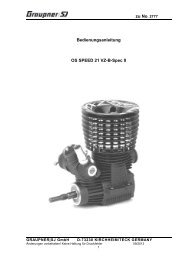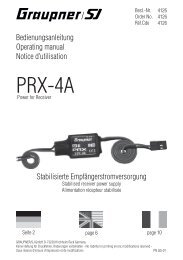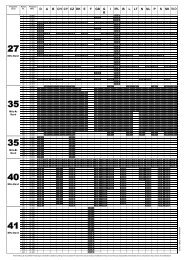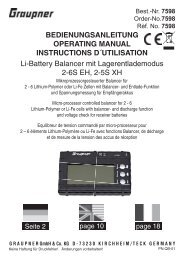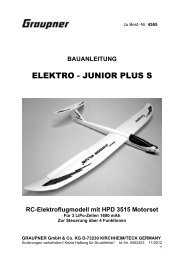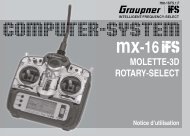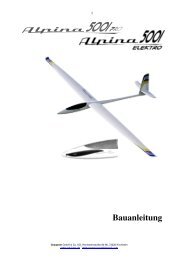Create successful ePaper yourself
Turn your PDF publications into a flip-book with our unique Google optimized e-Paper software.
place and drill 1.5 mm Ø holes at the ten marked points (Fig. 24).<br />
Cut ten spreader plates 18 - 20 mm wide from the plywood panel provided (200 x 15 x<br />
4 mm). Drill 1.5 mm Ø holes in the ply plates (Fig. 25), and glue them inside the<br />
fuselage at the screw positions using thickened epoxy resin. Screw the cowl in place<br />
to prevent the reinforcements shifting. We recommend that you install the complete<br />
engine system before screwing the cowl to the fuselage, so that you can check that<br />
the spinner backplate lines up correctly with the cowl. Use the M5 x 90 socket-head<br />
cap screw to secure the spinner backplate / spinner / engine (ZDZ engine only) (Fig.<br />
26). Plywood / self-tapping screws / washers, plywood panel (200 x 15 x 4 mm) in bag<br />
III.<br />
Completing the fuselage<br />
Establish the position of the undercarriage braces (8) in the fuselage (1) by laying the<br />
braces (8) against the captive nuts fixed to the undercarriage plate (Fig. 28) and fitting<br />
the other end under the GRP wing joiner sleeve (4) which is already in place (Figs. 27,<br />
33). Check that the installation is symmetrical, then tack the braces in place using<br />
cyano. Glue the plywood undercarriage braces (8) in place permanently using<br />
thickened epoxy resin and glass cloth (Fig. 30).<br />
The fueltank support former (9) should be installed at right-angles to the GRP sleeve<br />
(4). The large circular opening is designed to support the fueltank, and may need to<br />
be adjusted to suit the diameter of the tank you wish to install. We used a plastic 1<br />
litre Cola / Fanta bottle. We recommend that you trim the support former (9) to suit<br />
your fueltank before fitting it in the fuselage.<br />
Tack the front fueltank support (10) in the fuselage using cyano, then reinforce the<br />
joints with epoxy. The position of the support (10) is shown in the detail illustration<br />
(Fig. 34). When the model is complete the fueltank bottle is held in place by cable ties<br />
threaded through the holes in the support (10).<br />
Fit the two ring-screws in the fueltank support former (9) in the position shown in Fig.<br />
33. Drill 1.5 mm Ø pilot-holes and glue the ring-screws in place using UHU plus<br />
endfest 300 (slow-setting epoxy). The tension springs (25) which secure the exhaust<br />
are connected to these hooks.<br />
Fig. 35 shows the complete forward fuselage nose and former assembly, and also<br />
illustrates the large openings at the front between the undercarriage braces. Through<br />
these holes sufficient cooling air reaches the interior of the fuselage when the model<br />
is flying (all plywood formers and the ring-screws are in bag I).<br />
Servo plate<br />
You will find the servo plate (11) in bag I, but before you glue it in place permanently<br />
you need to determine the size and number of servos you intend to install to actuate<br />
the rudder. The plate is supplied with machined apertures for standard-size servos<br />
(Fig. 38), corresponding to the case size of <strong>Graupner</strong>/JR servos. The opening for a<br />
<strong>Graupner</strong>/JR DS 14021 Jumbo servo (14 kg/cm torque) is also marked (Fig. 37); if<br />
you are using such a servo you must cut out the opening along the marked lines. The<br />
servo plate also includes pre-cut openings which will accept the <strong>Graupner</strong>/JR<br />
switches, Order No. 3046 or 3050, plus the battery controller, Order No. 3138 (for<br />
receiving system / ignition system).<br />
11





